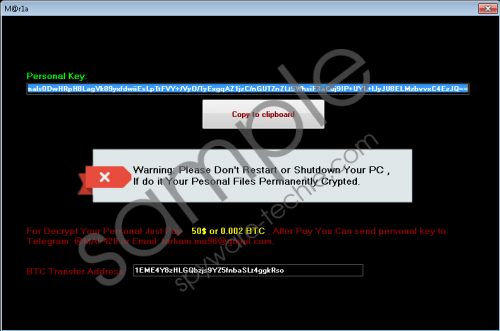Do you know what M@r1a Ransomware is?
M@r1a Ransomware is yet another ransomware infection that wants to rip you off. Ransomware programs have been terrorizing users worldwide for more than six years now, and it doesn’t look like this onslaught is going to end any time soon. It is important that you remove M@r1a Ransomware from your system, and then avoid similar intruders in the future. Please scroll down to the bottom of this description for the manual removal instructions. If you want to find out more about the infection itself, continue reading this entry.
Although this is not a high-profile infection, it doesn’t take a genius to figure out how it spreads around. Our research team suggests that M@r1a Ransomware uses the same ransomware distribution methods as most of the other programs from this category. What we do know for sure is that M@r1a Ransomware belongs to the same family as Spartacus, Satyr, and Blackheart ransomware. All these malicious infections share similar behavioral patterns, too. This also means that there might be a public decryption tool available for M@r1a Ransomware as well. Considering that this program has been out there for a while, you should definitely search for a public decryption tool before you get down to removing M@r1a Ransomware for good.
So, if this program uses the same distribution methods, what should we be aware of, if we want to avoid such intruders? First, let’s not forget that ransomware apps usually travel via spam email attachments. Hence, someone needs to open those attachments, right? It means that users unwittingly infect their systems with M@r1a Ransomware and other similar programs when they open new phishing emails or anything that comes from unknown senders. M@r1a Ransomware screenshot
M@r1a Ransomware screenshot
Scroll down for full removal instructions
Thus, you must learn how to recognize a potential threat. The main rule is that you should ignore unexpected messages that immediately call for action and urge you to open the attached file. If that happens, there is a good chance that the email carries a malware infection. Or, if you still think that you should open the file, you can scan the received file with a security tool before you open it.
Sometimes M@r1a Ransomware might also be distributed via unsafe RDP configuration or fake crack or key generation type of software. Just bear in mind that anything that is not official could easily lead to a dangerous malware infection.
When M@r1a Ransomware enters a target system, it scans it looking of the types of files it can encrypt. The program can technically encrypt almost anything, but it doesn’t touch the System files and the data in such locations as %PROGRAMFILES% and %WinDir%. In other words, your system still works even when the encryption is complete. You just cannot access your files because they are successfully locked up. If that doesn’t dawn upon you, you can see it for yourself by trying to open any affected file. You will see that each encrypted file has the ‘.mariacbc’ appendix added to its filename, and the system can no longer read it.
M@r1a Ransomware also displays a ransom note because it needs to push you into purchasing the decryption key. The ransom note is dropped in every folder that has encrypted files, and the message reads as follows:
Warning: Please Don’t Restart or Shutdown Your PC, If do it Your Personal Files Permanently Crypted.
For Decrypt Your Personal Just Pay 50$ or 0.002 BTC. After Pay You Can send personal key to Telegram: @MAF420 or Email: farhani.ma98@gmail.com.
The message also displays the BTC wallet address that the infected user should use to transfer the ransom to. There’s also the personal key that can be used to identify the user when they contact these criminals to inform them about the transfer. However, we all know that transferring the ransom doesn’t guarantee these criminals would issue the decryption key in the first place.
Thus, you should never waste your money on these crooks. Remove M@r1a Ransomware right now, and then look for ways to restore your files. Check for the public decryption tool, and if it is not available, you should be able to restore your files from an external backup. If you do not have one, check out your mobile devices, online drives, and email inbox for the most recent files.
How to Remove M@r1a Ransomware
- Delete unfamiliar files and the ransom note from Desktop.
- Go to the Donwloads folder.
- Remove the most recently download files.
- Press Win+R and type %TEMP%. Click OK.
- Remove the most recent files.
- Delete the ReadME-M@r1a.txt ransom note from %HOMEDRIVE%.
- Scan your computer with SpyHunter.
In non-techie terms:
M@r1a Ransomware might be just another ransomware infection, but it doesn’t mean we should overlook it. It can block your file access by encrypting every single personal file, and then it will ask you to pay for the decryption tool to unlock them. Security experts always emphasize the importance of a file backup, so be sure to regularly back up your files in an external hard disk, to mitigate the consequences of potential future malware infections.
